
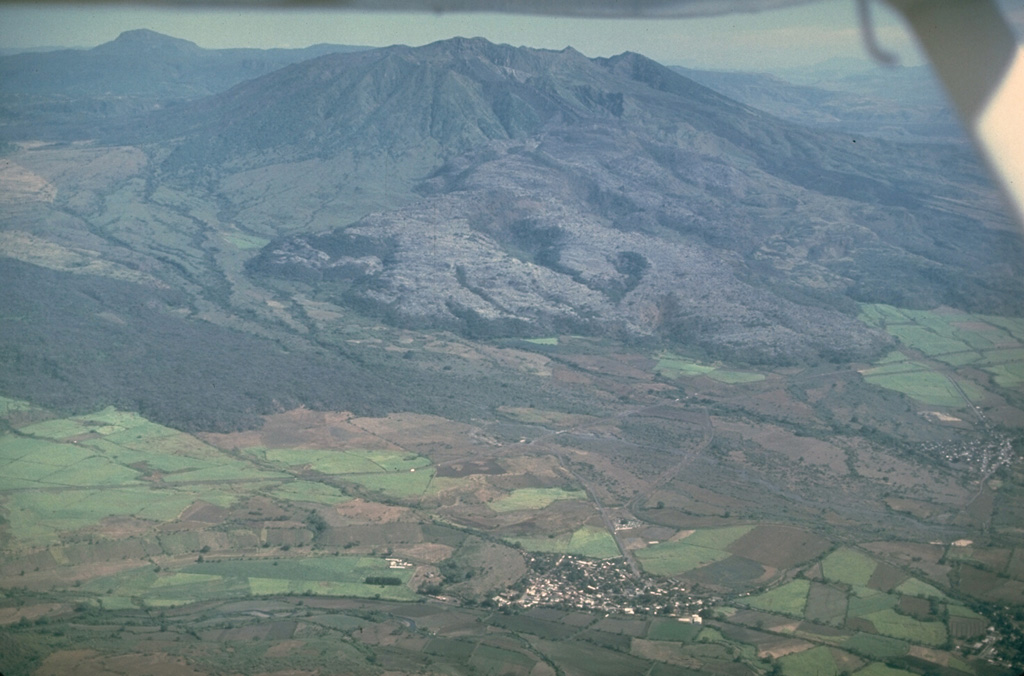
The Global Volcanism Program has no activity reports available for Ceboruco.
The Global Volcanism Program has no Weekly Reports available for Ceboruco.
The Global Volcanism Program has no Bulletin Reports available for Ceboruco.
|
|
||||||||||||||||||||||||||||
There is data available for 4 confirmed Holocene eruptive periods.
1870 Feb 21 - 1875 Confirmed Eruption (Explosive / Effusive) VEI: 3
| Episode 1 | Eruption (Explosive / Effusive) | Upper west flank | ||||||||||||||||||||||||||||||||||||||||||||||||||||||
|---|---|---|---|---|---|---|---|---|---|---|---|---|---|---|---|---|---|---|---|---|---|---|---|---|---|---|---|---|---|---|---|---|---|---|---|---|---|---|---|---|---|---|---|---|---|---|---|---|---|---|---|---|---|---|---|
| 1870 Feb 21 - 1875 | Evidence from Observations: Reported | ||||||||||||||||||||||||||||||||||||||||||||||||||||||
|
List of 9 Events for Episode 1 at Upper west flank
|
|||||||||||||||||||||||||||||||||||||||||||||||||||||||
1567 Confirmed Eruption (Explosive / Effusive)
| Episode 1 | Eruption (Explosive / Effusive) | ||||||||||||||||||||
|---|---|---|---|---|---|---|---|---|---|---|---|---|---|---|---|---|---|---|---|---|
| 1567 - Unknown | Evidence from Observations: Reported | |||||||||||||||||||
|
List of 2 Events for Episode 1
|
||||||||||||||||||||
1542 Confirmed Eruption (Explosive / Effusive)
| Episode 1 | Eruption (Explosive / Effusive) | |||||||||||||||
|---|---|---|---|---|---|---|---|---|---|---|---|---|---|---|---|
| 1542 - Unknown | Evidence from Observations: Reported | ||||||||||||||
|
List of 1 Events for Episode 1
|
|||||||||||||||
0930 ± 200 years Confirmed Eruption (Explosive / Effusive) VEI: 6
| Episode 1 | Eruption (Explosive / Effusive) | Jala Pumice | ||||||||||||||||||||||||||||||||||
|---|---|---|---|---|---|---|---|---|---|---|---|---|---|---|---|---|---|---|---|---|---|---|---|---|---|---|---|---|---|---|---|---|---|---|---|
| 0930 ± 200 years - Unknown | Evidence from Isotopic: 14C (uncalibrated) | ||||||||||||||||||||||||||||||||||
|
List of 5 Events for Episode 1 at Jala Pumice
|
|||||||||||||||||||||||||||||||||||
This compilation of synonyms and subsidiary features may not be comprehensive. Features are organized into four major categories: Cones, Craters, Domes, and Thermal Features. Synonyms of features appear indented below the primary name. In some cases additional feature type, elevation, or location details are provided.
Synonyms |
||||
| Ahuacatlán, Volcán de | ||||
Cones |
||||
| Feature Name | Feature Type | Elevation | Latitude | Longitude |
| Ceboroquito
Molcajete, Volcán |
Pyroclastic cone | 1360 m | 21° 6' 0.00" N | 104° 28' 0.00" W |
| Molcajete Grande, Volcán | Pyroclastic cone | 1560 m | 21° 10' 30.00" N | 104° 32' 30.00" W |
| Pichancha, La | Pyroclastic cone | 1140 m | 21° 4' 0.00" N | 104° 26' 30.00" W |
Domes |
||||
| Feature Name | Feature Type | Elevation | Latitude | Longitude |
| Centro, El | Dome | 2240 m | 21° 7' 0.00" N | 104° 31' 0.00" W |
| Dos Equis | Dome | 2200 m | 21° 7' 0.00" N | 104° 30' 0.00" W |
| Pedregoso, Cerro | Dome | 1300 m | 21° 6' 0.00" N | 104° 27' 30.00" W |
| Pochetero, Cerro | Dome | 1280 m | 21° 5' 30.00" N | 104° 27' 0.00" W |
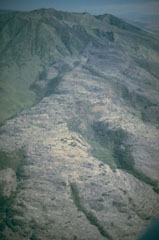 An eruption of Ceboruco volcano began in 1870 and produced the lava flow shown here from the west. Explosive eruptions began from a vent near the western caldera rim in February 1870 and continued with emission of the 1.1 km3 lava flow, which traveled 6 km down the lower flank. The eruption continued sporadically for 5 years, causing extensive damage to livestock and crops. Hundreds of people were forced to abandon their homes.
An eruption of Ceboruco volcano began in 1870 and produced the lava flow shown here from the west. Explosive eruptions began from a vent near the western caldera rim in February 1870 and continued with emission of the 1.1 km3 lava flow, which traveled 6 km down the lower flank. The eruption continued sporadically for 5 years, causing extensive damage to livestock and crops. Hundreds of people were forced to abandon their homes.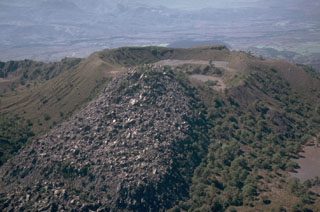 A small lava flow, possibly produced during or before the 1870-75 eruption of Ceboruco, descended eastward from the rim of a crater within the inner caldera. This flow traveled 500 m to the east. The small crater to the right of the flow formed in the NE side of the larger crater. These are part of a complex group of features within the nested summit calderas.
A small lava flow, possibly produced during or before the 1870-75 eruption of Ceboruco, descended eastward from the rim of a crater within the inner caldera. This flow traveled 500 m to the east. The small crater to the right of the flow formed in the NE side of the larger crater. These are part of a complex group of features within the nested summit calderas.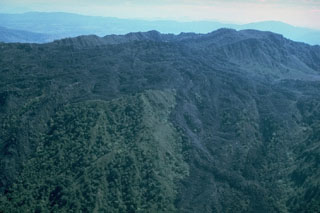 The El Norte lava flows, which cover much of the northern flank of Ceboruco, were erupted along buried ring fractures within nested calderas. The flows split into two lobes, a broad northern lobe that reached the base of the volcano and a narrower NW lobe (lower right). The southern wall of the inner caldera forms the irregular ridge behind the flows (below the distant haze), with the summit cone and lava flows visible at top right.
The El Norte lava flows, which cover much of the northern flank of Ceboruco, were erupted along buried ring fractures within nested calderas. The flows split into two lobes, a broad northern lobe that reached the base of the volcano and a narrower NW lobe (lower right). The southern wall of the inner caldera forms the irregular ridge behind the flows (below the distant haze), with the summit cone and lava flows visible at top right.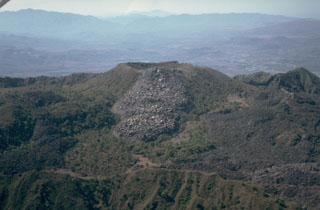 This aerial view looks from the east across the inner summit caldera of Ceboruco. The unvegetated lava flow in the center was emplaced either in 1870-75, or during earlier eruptions in 1542 or 1567. The flow covering the caldera floor to the lower right is the near-vent portion of the voluminous El Norte lava flows. The ridge in the foreground is the eastern rim of the inner caldera.
This aerial view looks from the east across the inner summit caldera of Ceboruco. The unvegetated lava flow in the center was emplaced either in 1870-75, or during earlier eruptions in 1542 or 1567. The flow covering the caldera floor to the lower right is the near-vent portion of the voluminous El Norte lava flows. The ridge in the foreground is the eastern rim of the inner caldera.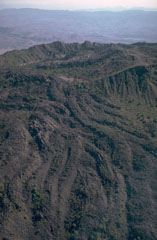 The El Norte lava flows cover most of the N flank of Ceboruco volcano in western México. The south wall of the inner caldera forms the far summit ridge. The andesitic El Norte flows cover a broad area 3.5 km in length and forms a 3.5-km-wide lava flow field at the base of the volcano. Their youthful morphology and unvegetated surfaces suggest a young age, possibly during one of the two 16th century eruptions.
The El Norte lava flows cover most of the N flank of Ceboruco volcano in western México. The south wall of the inner caldera forms the far summit ridge. The andesitic El Norte flows cover a broad area 3.5 km in length and forms a 3.5-km-wide lava flow field at the base of the volcano. Their youthful morphology and unvegetated surfaces suggest a young age, possibly during one of the two 16th century eruptions.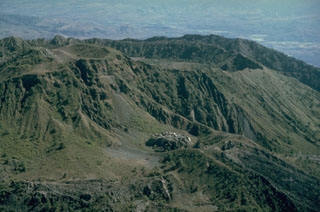 This aerial view of the western part of the summit of Ceboruco shows the rims of the two nested calderas to the upper right. The vent of the 1870-75 eruption contains a small lava dome below center of this photo. A massive lava flow erupted during the 1870 eruption and descended to the lower right.
This aerial view of the western part of the summit of Ceboruco shows the rims of the two nested calderas to the upper right. The vent of the 1870-75 eruption contains a small lava dome below center of this photo. A massive lava flow erupted during the 1870 eruption and descended to the lower right. 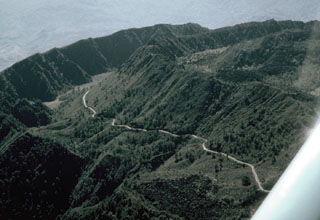 The walls of two nested summit calderas are seen here in an aerial view of Ceboruco from the NE, with the road to the summit. The formation of the 3.7-km-wide outer caldera was associated with eruption of the 5 km3 Jala Pumice and the Marquesado pyroclastic flow about 1,000 years ago. The Jala Pumice covers broad areas to the north and east.
The walls of two nested summit calderas are seen here in an aerial view of Ceboruco from the NE, with the road to the summit. The formation of the 3.7-km-wide outer caldera was associated with eruption of the 5 km3 Jala Pumice and the Marquesado pyroclastic flow about 1,000 years ago. The Jala Pumice covers broad areas to the north and east. Volcán Ceboruco is a small, but complex stratovolcano with two concentric summit calderas. The thick lava flow (center) on the western flank was emplaced during an eruption in 1870-75. Eruption of the rhyodacite Jala Pumice formed the initial 4-km-wide caldera about 1,000 years ago. The second caldera was associated with partial collapse of the large Dos Equis dacite lava dome, which partly filled the earlier caldera. About 15 scoria cones and lava flows are across the flanks.
Volcán Ceboruco is a small, but complex stratovolcano with two concentric summit calderas. The thick lava flow (center) on the western flank was emplaced during an eruption in 1870-75. Eruption of the rhyodacite Jala Pumice formed the initial 4-km-wide caldera about 1,000 years ago. The second caldera was associated with partial collapse of the large Dos Equis dacite lava dome, which partly filled the earlier caldera. About 15 scoria cones and lava flows are across the flanks.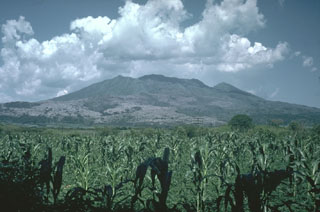 Ceboruco, seen here from the west, contains two summit calderas. The rim of the older caldera, which collapsed about 1,000 years ago following eruption of the Jala Pumice, forms the peaks to the left and right of the summit. The thick, light-gray-colored lava flow at the mid left and center part of the photo was produced during the 1870-75 eruption.
Ceboruco, seen here from the west, contains two summit calderas. The rim of the older caldera, which collapsed about 1,000 years ago following eruption of the Jala Pumice, forms the peaks to the left and right of the summit. The thick, light-gray-colored lava flow at the mid left and center part of the photo was produced during the 1870-75 eruption.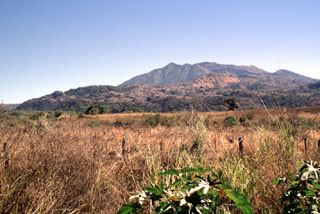 The sparsely vegetated ridge across the center of the photo is the distal margin of the Ceboruco 1870 lava flow. The 1.1 km3 lava flow originated from a vent at the western side of the nested summit calderas and traveled 6.5 km down the Arroyo de los Cuates valley to about 900 m elevation. The notch on the right-hand side of the summit ridge is the moat between the nested calderas.
The sparsely vegetated ridge across the center of the photo is the distal margin of the Ceboruco 1870 lava flow. The 1.1 km3 lava flow originated from a vent at the western side of the nested summit calderas and traveled 6.5 km down the Arroyo de los Cuates valley to about 900 m elevation. The notch on the right-hand side of the summit ridge is the moat between the nested calderas.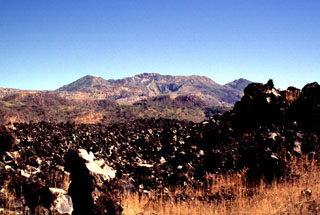 The unvegetated Ceboruco lava flow in the foreground appears to be some of the youngest of the W-flank flows. The peaks on either side of the broad summit in this view from the WSW are the rims of the 4-km-wide outer caldera.
The unvegetated Ceboruco lava flow in the foreground appears to be some of the youngest of the W-flank flows. The peaks on either side of the broad summit in this view from the WSW are the rims of the 4-km-wide outer caldera.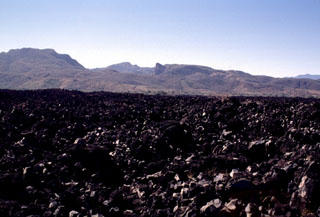 Highway 15 cuts across the lava flow that extends 7 km down the SW flank of Ceboruco. Maps show that this flow, referred to as El Ceboruco, existed prior to the 1870 eruption. Pliocene ignimbrites form the hills in the background.
Highway 15 cuts across the lava flow that extends 7 km down the SW flank of Ceboruco. Maps show that this flow, referred to as El Ceboruco, existed prior to the 1870 eruption. Pliocene ignimbrites form the hills in the background.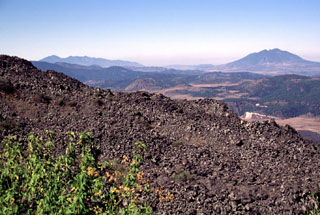 The El Norte lava flows of Ceboruco in the foreground cover much of the northern flank. These young flows erupted from vents within the inner summit caldera and may have been emplaced during one of two 16th-century eruptions. The lava flows traveled 3.5 km down the north flank and formed a broad, 3.5-km-wide front at the base of the volcano. The volcano with the irregular profile in the left distance is Tepetiltic; Sangangüey forms the peak to the far right.
The El Norte lava flows of Ceboruco in the foreground cover much of the northern flank. These young flows erupted from vents within the inner summit caldera and may have been emplaced during one of two 16th-century eruptions. The lava flows traveled 3.5 km down the north flank and formed a broad, 3.5-km-wide front at the base of the volcano. The volcano with the irregular profile in the left distance is Tepetiltic; Sangangüey forms the peak to the far right.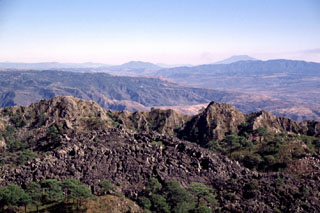 The inner caldera rim of Ceboruco forms the ridge extending across the photo in this view looking toward the SE from near the summit. The inner caldera wall consists of massive dome lavas that were emplaced within the outer caldera. The unvegetated lava flow in the foreground was erupted from a vent within a scoria cone complex at the western side of the inner caldera, probably in 1870. Flat-topped Volcán Tequila forms the peak in distance to the upper right.
The inner caldera rim of Ceboruco forms the ridge extending across the photo in this view looking toward the SE from near the summit. The inner caldera wall consists of massive dome lavas that were emplaced within the outer caldera. The unvegetated lava flow in the foreground was erupted from a vent within a scoria cone complex at the western side of the inner caldera, probably in 1870. Flat-topped Volcán Tequila forms the peak in distance to the upper right.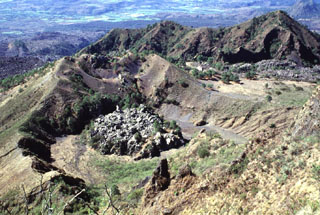 The small lava dome on the floor of the crater in the foreground was emplaced late in the 1870-75 eruption of Ceboruco. Levees of a lava flow that traveled 6.5 km down the west flank are higher than this crater, indicating that the main 1870 vent that fed the flows was probably located above the dome. The ridge to the upper right is the NW rim of the outer caldera.
The small lava dome on the floor of the crater in the foreground was emplaced late in the 1870-75 eruption of Ceboruco. Levees of a lava flow that traveled 6.5 km down the west flank are higher than this crater, indicating that the main 1870 vent that fed the flows was probably located above the dome. The ridge to the upper right is the NW rim of the outer caldera.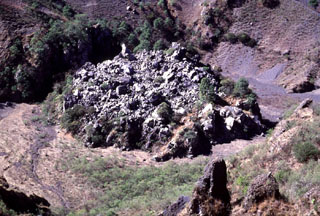 A small lava dome was extruded in the main vent of the 1870-75 eruption of Ceboruco volcano in western México. Fumaroles (not visible in this photo) with temperatures measured at about 100°C were located around the base of the dome when the photo was taken in 1997.
A small lava dome was extruded in the main vent of the 1870-75 eruption of Ceboruco volcano in western México. Fumaroles (not visible in this photo) with temperatures measured at about 100°C were located around the base of the dome when the photo was taken in 1997. 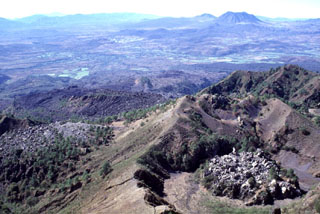 The view of the 1870 vent and the San Pedro-Ceboruco graben is from the Ceboruco summit. The small lava dome to the lower right and the unvegetated lava flow to the lower left were emplaced during the 1870-75 eruption. The Cerro San Pedro lava dome on the horizon directly above the 1870 dome was constructed within the 7 x 10 km San Pedro caldera. The peak immediately left of Cerro San Pedro is Cerro Tetillas.
The view of the 1870 vent and the San Pedro-Ceboruco graben is from the Ceboruco summit. The small lava dome to the lower right and the unvegetated lava flow to the lower left were emplaced during the 1870-75 eruption. The Cerro San Pedro lava dome on the horizon directly above the 1870 dome was constructed within the 7 x 10 km San Pedro caldera. The peak immediately left of Cerro San Pedro is Cerro Tetillas.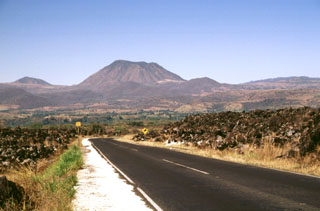 The flat-topped rhyolitic Los Ocotes lava dome (center) was erupted on the southern flank of Tepetiltic volcano about 100,000 years ago and is the youngest product of that complex. Extrusion of the dome blocked drainages to form Laguna San Pedro, out of view to the left. The rim of Tepetiltic caldera forms the right horizon. Los Ocotes is seen here from the SE along Highway 15 where it crosses the blocky andesitic El Ceboruco lava flow in the foreground, which traveled 8 km from Ceboruco volcano.
The flat-topped rhyolitic Los Ocotes lava dome (center) was erupted on the southern flank of Tepetiltic volcano about 100,000 years ago and is the youngest product of that complex. Extrusion of the dome blocked drainages to form Laguna San Pedro, out of view to the left. The rim of Tepetiltic caldera forms the right horizon. Los Ocotes is seen here from the SE along Highway 15 where it crosses the blocky andesitic El Ceboruco lava flow in the foreground, which traveled 8 km from Ceboruco volcano.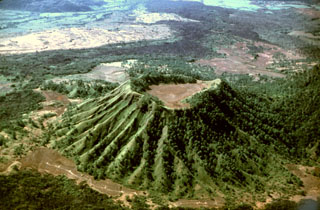 Erosional gullies have formed down the Molcajete Grande flanks, a cone on the lower NW flank of Ceboruco. This aerial view from the NE shows the forested andesite Coapan lava flow beyond the cone. The lighter-colored area just beyond the flow (upper left) is the Destiladero rhyodacitic lava flow.
Erosional gullies have formed down the Molcajete Grande flanks, a cone on the lower NW flank of Ceboruco. This aerial view from the NE shows the forested andesite Coapan lava flow beyond the cone. The lighter-colored area just beyond the flow (upper left) is the Destiladero rhyodacitic lava flow.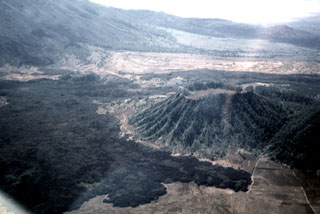 The dark Coapan andesite lava flow surrounds the Molcajete Grande cone (right center) on the NW flank of Ceboruco, whose slopes are visible to the upper left. The light-colored area across the upper part of the photo beyond the forested Coapan flow is the rhyodacite Destiladero lava flow.
The dark Coapan andesite lava flow surrounds the Molcajete Grande cone (right center) on the NW flank of Ceboruco, whose slopes are visible to the upper left. The light-colored area across the upper part of the photo beyond the forested Coapan flow is the rhyodacite Destiladero lava flow. The following 20 samples associated with this volcano can be found in the Smithsonian's NMNH Department of Mineral Sciences collections, and may be availble for research (contact the Rock and Ore Collections Manager). Catalog number links will open a window with more information.
| Catalog Number | Sample Description | Lava Source | Collection Date |
|---|---|---|---|
| NMNH 116285-1 | Basaltic Lava | -- | 1 Feb 1947 |
| NMNH 116285-2 | Porphyritic Lava | -- | 1 Feb 1947 |
| NMNH 116285-3 | Volcanic Ash | -- | 1 Feb 1947 |
| NMNH 117253-35 | Andesite | -- | -- |
| NMNH 117253-36 | Andesite | -- | -- |
| NMNH 117591-1 | Andesitic Dacite | -- | -- |
| NMNH 117591-10 | Dacite | -- | -- |
| NMNH 117591-11 | Andesitic Dacite | -- | -- |
| NMNH 117591-12 | Andesite | -- | -- |
| NMNH 117591-13 | Andesite | -- | -- |
| NMNH 117591-2 | Andesitic Dacite | -- | -- |
| NMNH 117591-3 | Andesitic Dacite | -- | -- |
| NMNH 117591-4 | Andesitic Dacite | -- | -- |
| NMNH 117591-5 | Andesitic Dacite | -- | -- |
| NMNH 117591-6 | Andesite | -- | -- |
| NMNH 117591-7 | Dacite | -- | -- |
| NMNH 117591-8 | Andesite | -- | -- |
| NMNH 117591-9 | Dacite | -- | -- |
| NMNH 117623-66 | Basalt | Volcán Molcajete | -- |
| NMNH 117623-67 | Scoria | Volcán Molcajete | -- |
| Copernicus Browser | The Copernicus Browser replaced the Sentinel Hub Playground browser in 2023, to provide access to Earth observation archives from the Copernicus Data Space Ecosystem, the main distribution platform for data from the EU Copernicus missions. |
| MIROVA | Middle InfraRed Observation of Volcanic Activity (MIROVA) is a near real time volcanic hot-spot detection system based on the analysis of MODIS (Moderate Resolution Imaging Spectroradiometer) data. In particular, MIROVA uses the Middle InfraRed Radiation (MIR), measured over target volcanoes, in order to detect, locate and measure the heat radiation sourced from volcanic activity. |
| MODVOLC Thermal Alerts | Using infrared satellite Moderate Resolution Imaging Spectroradiometer (MODIS) data, scientists at the Hawai'i Institute of Geophysics and Planetology, University of Hawai'i, developed an automated system called MODVOLC to map thermal hot-spots in near real time. For each MODIS image, the algorithm automatically scans each 1 km pixel within it to check for high-temperature hot-spots. When one is found the date, time, location, and intensity are recorded. MODIS looks at every square km of the Earth every 48 hours, once during the day and once during the night, and the presence of two MODIS sensors in space allows at least four hot-spot observations every two days. Each day updated global maps are compiled to display the locations of all hot spots detected in the previous 24 hours. There is a drop-down list with volcano names which allow users to 'zoom-in' and examine the distribution of hot-spots at a variety of spatial scales. |
|
WOVOdat
Single Volcano View Temporal Evolution of Unrest Side by Side Volcanoes |
WOVOdat is a database of volcanic unrest; instrumentally and visually recorded changes in seismicity, ground deformation, gas emission, and other parameters from their normal baselines. It is sponsored by the World Organization of Volcano Observatories (WOVO) and presently hosted at the Earth Observatory of Singapore.
GVMID Data on Volcano Monitoring Infrastructure The Global Volcano Monitoring Infrastructure Database GVMID, is aimed at documenting and improving capabilities of volcano monitoring from the ground and space. GVMID should provide a snapshot and baseline view of the techniques and instrumentation that are in place at various volcanoes, which can be use by volcano observatories as reference to setup new monitoring system or improving networks at a specific volcano. These data will allow identification of what monitoring gaps exist, which can be then targeted by remote sensing infrastructure and future instrument deployments. |
| Volcanic Hazard Maps | The IAVCEI Commission on Volcanic Hazards and Risk has a Volcanic Hazard Maps database designed to serve as a resource for hazard mappers (or other interested parties) to explore how common issues in hazard map development have been addressed at different volcanoes, in different countries, for different hazards, and for different intended audiences. In addition to the comprehensive, searchable Volcanic Hazard Maps Database, this website contains information about diversity of volcanic hazard maps, illustrated using examples from the database. This site is for educational purposes related to volcanic hazard maps. Hazard maps found on this website should not be used for emergency purposes. For the most recent, official hazard map for a particular volcano, please seek out the proper institutional authorities on the matter. |
| IRIS seismic stations/networks | Incorporated Research Institutions for Seismology (IRIS) Data Services map showing the location of seismic stations from all available networks (permanent or temporary) within a radius of 0.18° (about 20 km at mid-latitudes) from the given location of Ceboruco. Users can customize a variety of filters and options in the left panel. Note that if there are no stations are known the map will default to show the entire world with a "No data matched request" error notice. |
| UNAVCO GPS/GNSS stations | Geodetic Data Services map from UNAVCO showing the location of GPS/GNSS stations from all available networks (permanent or temporary) within a radius of 20 km from the given location of Ceboruco. Users can customize the data search based on station or network names, location, and time window. Requires Adobe Flash Player. |
| DECADE Data | The DECADE portal, still in the developmental stage, serves as an example of the proposed interoperability between The Smithsonian Institution's Global Volcanism Program, the Mapping Gas Emissions (MaGa) Database, and the EarthChem Geochemical Portal. The Deep Earth Carbon Degassing (DECADE) initiative seeks to use new and established technologies to determine accurate global fluxes of volcanic CO2 to the atmosphere, but installing CO2 monitoring networks on 20 of the world's 150 most actively degassing volcanoes. The group uses related laboratory-based studies (direct gas sampling and analysis, melt inclusions) to provide new data for direct degassing of deep earth carbon to the atmosphere. |
| Large Eruptions of Ceboruco | Information about large Quaternary eruptions (VEI >= 4) is cataloged in the Large Magnitude Explosive Volcanic Eruptions (LaMEVE) database of the Volcano Global Risk Identification and Analysis Project (VOGRIPA). |
| EarthChem | EarthChem develops and maintains databases, software, and services that support the preservation, discovery, access and analysis of geochemical data, and facilitate their integration with the broad array of other available earth science parameters. EarthChem is operated by a joint team of disciplinary scientists, data scientists, data managers and information technology developers who are part of the NSF-funded data facility Integrated Earth Data Applications (IEDA). IEDA is a collaborative effort of EarthChem and the Marine Geoscience Data System (MGDS). |